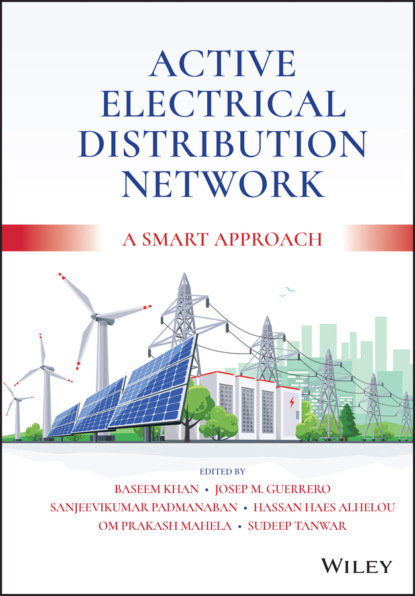Unit Placement Chapter 10: Enhancing the Performance of the State Estimation Algorithm Through Optimally Placed Phasor Measurement Units
15 Part VII: Smart Microgrid Integration and Optimization Chapter 11: Smart Microgrid Integration and Optimization Chapter 12: Control Algorithms for Energy Storage Systems to Reduce Distribution Power Loss of Microgrids Chapter 13: Higher Levels of Wind Energy Penetration into the Remote Grid: Challenges and Solutions Chapter 14: Internet of Things and Machine Learning for Improving Solar-PV Plant Efficiency: Forecasting Aspects Chapter 15: Modular Design of Nonlinear Controllers for Photovoltaic Distributed Generation Systems
16 Part VIII: Electric Vehicle Technology Chapter 16: Vehicle-to-Grid Challenges and Potential Benefits for Smart Microgrids
17 Part IX: Reconfiguration of a Smart Distribution Network Chapter 17: Reconfiguration of Radial Distribution Systems: Test System Chapter 18: Distribution System Reconfiguration: Case Studies Chapter 19: Genetic Algorithm Application in Distribution System Reconfiguration
18 Part X: Demand Side Management Mechanisms and a Smart Home Energy Management System Chapter 20: Demand Response Techniques and Smart Home Energy Management Systems Chapter 21: A Sustainable Building Lightning Solution for Energy Conservation in Different Geographical Conditions
19 Part XI: Smart Meter Technology Chapter 22: Smart Metering: Transforming from One-Way to Two-Way Communication
20 Index
List of Illustrations
1 Chapter 1Figure 1.1 Different distribution models evolved.Figure 1.2 Single vertical structure.Figure 1.3 Unbundled structure.Figure 1.4 Input-based franchisee model.Figure 1.5 Nobel business model for power distribution.
2 Chapter 2Figure 2.1 Methodology for deducing the optimal switching frequency.Figure 2.2 IEEE 33-bus radial distribution system.
3 Chapter 3Figure 3.1 Problems in the distribution systems.
4 Chapter 4Figure 4.1 ICCT controlled DSTATCOM-BESS system connected at PCC.Figure 4.2 System scheme of D-STATCOM with BESS.Figure 4.3 ICCT-based control algorithm for DSTATCOM-BESS.Figure 4.4 MATLAB simulation of indirect current control...Figure 4.5 Response of DSTATCOM-BESS under a balanced linear load.Figure 4.6 Response of DSTATCOM-BESS under a nonlinear load.Figure 4.7 Source side frequency spectrum.Figure 4.8 Load side frequency spectrum.Figure 4.9 Response of DSTATCOM-BESS under an induction motor load.Figure 4.10 Source side frequency spectrum.Figure 4.11 Load side frequency spectrum.Figure 4.12 Response of DSTATCOM-BESS under an unbalanced linear load.Figure 4.13 Source side frequency spectrum.Figure 4.14 Load side frequency spectrum.Figure 4.15 Response of DSTATCOM-BESS under an unbalanced nonlinear load.Figure 4.16 Source side frequency spectrum.Figure 4.17 Load side frequency spectrum.Figure 4.18 Response of DSTATCOM-BESS under an unbalanced motor load.Figure 4.19 Source side frequency spectrum.Figure 4.20 Load side frequency spectrum.
5 Chapter 5Figure 5.1 EV battery charger model.Figure 5.2 Circuit configuration of grid facing converter.Figure 5.3 EV charger controller block diagram.Figure 5.4 Frequency domain response of the resonant filter.Figure 5.5 (a) Performance of the charger with battery...Figure 5.6 (a) Performance of the charger with battery...Figure 5.7 Performance of EV charger during battery...Figure 5.8 Performance of EV charger during battery...Figure 5.9 Performance of EV charger during battery...
6 Chapter 6Figure 6.1 Traditional architecture of power flow in an...Figure 6.2 Comparison of communication architecture between a...Figure 6.3 Three-layered infrastructure of a smart grid.
7 Chapter 7Figure 7.1 DMS functions division.Figure 7.2 Interaction between different...Figure 7.3 Conceptual design of the DMS.
8 Chapter 8Figure 8.1 Capacitor banks and their impacts...Figure 8.2 Network losses during different...Figure 8.3 Load demand during different operating scenarios.Figure 8.4 Percentage energy savings per year at...Figure 8.5 Impact of percentage voltage change on...Figure 8.6 Voltage profile during different test cases.Figure 8.7 Line losses during different test cases.Figure 8.8 Load drawl during different test cases.
9 Chapter 9Figure 9.1 Active network management solutions...Figure 9.2 An example of a seasonally adaptive QU-droop.Figure 9.3 Traffic light concept.Figure 9.4 An example for some flexible energy...Figure 9.5 Peak shaving performed by ESSs.Figure 9.6 The required battery capacity calculation for peak shaving.Figure 9.7 Schematic of integration of BESS to the distribution network.Figure 9.8 Different types of ESS technologies.
10 Chapter 2Figure 10.1 WLS algorithm.Figure 10.2 IEEE 14-bus observability analysis.Figure 10.3 21-bus Southern region system observability analysis.
11 Chapter 11Figure 11.1 Architecture of smart grid by Federal Department of Energy.Figure 11.2 The smart grid – Architecture 2.Figure 11.3 Smart grid multilayered architecture.Figure 11.4 Interdependencies between smart cities, smart...Figure 11.5 Architecture of smart microgrid system.Figure 11.6 Classifications of demand response.Figure 11.7 The smart agent.Figure 11.8 Smart agent model.Figure 11.9 Classification of smart agents.Figure 11.10 Basic flow chart of a genetic algorithm.Figure 11.11 Basic flow chart of a particle swarm optimization.Figure 11.12 Basic flow chart of a harmony search algorithm.Figure 11.13 Basic flow chart of a Tabu search algorithm.Figure 11.14 Basic flow chart for optimum position and size of the DG.
12 Chapter 12Figure 12.1 A typical DBS controlled by the ADE-based...Figure 12.2 Flowchart of the proposed control algorithm.Figure 12.3 Topology of the five-bus 48 V DC microgrid.Figure 12.4 Waveforms of RES power and bus voltages without DBS.Figure 12.5 Bus voltage waveforms for the DBS controlled by the PI controllers.Figure 12.6 Bus voltages waveforms for the DBS controlled by...Figure 12.7 SoC of the batteries for the DBS controlled by...Figure 12.8 Power loss waveforms of the two control schemes.Figure 12.9 Block diagram of the PSO-based hierarchical control.Figure 12.10 Flowchart of the PSO-based hierarchical control.Figure 12.11 Structure of the five-bus AC microgrid.Figure 12.12 (a) bus voltages, (b) references, and (c) fitness values for...Figure 12.13 Comparative bar charts of the PSO control with different weighting factors.Figure 12.14 SoC of the batteries for the DBS at buses 2 and 4.Figure 12.15 Flowchart of the CMPC algorithm.Figure 12.16 The 48 V five-bus DC microgrid without DBS in simulation.Figure 12.17 Waveforms of the bus voltages of the DC microgrid with four DCES.Figure 12.18 Distribution power loss for different weighting factors.Figure 12.19 Adaptive weighting factor.Figure 12.20 Comparisons of the distribution energy saving between...Figure 12.21 Comprehensive control block diagram of the predictive...Figure 12.22 Architecture of the three-bus microgrid in the experiment.Figure 12.23 Bus 1 voltage waveforms without and with ES during the period...Figure 12.24
